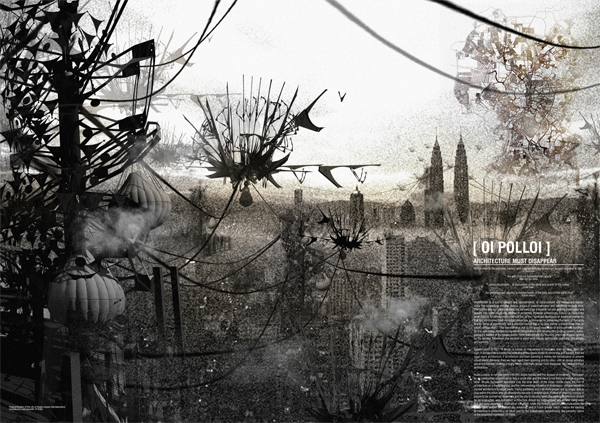竞赛主题: 演变中的建筑——建筑的消融
有时,我们使建筑消失。使它与地域相融合。模糊掉建筑与地域之间、有形与无形之间以及存在与缺失之间的界线……【大学生竞赛优秀奖OI POLLOI - A Manifesto 】
学生姓名:Mohamad Qaisyfullah Bin Jaslenda; Muhammad Hazim Bim Azami; Hanis Bin Abd Razak
指导老师:Aida Kesuma Binti Azmin; Aliyah Nur Zafirah Bt. Sanusi
作品名称:OI POLLOI - A Manifesto
学校名称:International Islamic University Malay
设计说明:
Architecture must disappear (?)
"Architecture is the masterly, correct, and magnificient play of masses brought together in light"
- Le Corbusier
"..the will of epoch translated into space"
- Mies Van Der Rohe
"..stone documents... in expression of the unity and power of the nation"
- Adolf Hitler
"..the moulding and altering to human needs of the very face of the earth itself"
- William Morris
Architecture as a tool of thought and representation, of socio-cultural and behavioural expressions has undeniably endured various stages of experimentation and definitions through time. The history tells us how its defining has evolved from a humble hut into soaring colonnades and arches, into super-structures, shrines of modernity. However interestingly, Franco La Cecla in his book Against Architecture summarised this as the "symbolic excellence of American modernity that has transformed itself into turgid showcase, a shrine not for preserving the fabric of humanity and its sense of community, but a physical format that is by now merely a brand rather than an urban configuration." This speculation is due to the grand separation of public-private buildings, as it is now being idolised by capitalistic corporations and bureaucratic political powers, subjugating the welfare of the greater public. Most dramatically, the housing and civic designs typified by the Modern Movement has become a world wide failure, technically, culturally, climatically, and socially.
Natalini wrote in 1971 "If design is merely an inducement to consume, then we must reject design; if architecture is merely the codifying of bourgeois model of ownership and society, then we must reject architecture; if architecture and town planning is merely the formalization of present unjust social divisions, then we must reject town planning and its cities, until all design activities are aimed towards meeting primary needs. Until then, design must disappear. We can live without architecture."
Kuala Lumpur is not exempted from this utopia fantasy and the disease of modernity. The majority of construction projects serve only a small elite and this trend is not likely to change any time soon. Nicolai Ouroussoff described it as the slow death of the urban middle class, the rise of architecture as a marketing tool, and the overweening influence of developers - all have helped to narrow architecture's social reach. Young graduates and a lot more people are no longer able to stay within the urban area as affordability became a striking issue. Instead of allowing masses of people to be pushed out elsewhere and the city to become dead, the existing architecture should be reconstructed, and monolithic architecture should be fragmantised into smaller living units that are moreessential in such urban condition, while the mobility and infrastructure within the urban fabric should be dramatically enhanced and of much greater reach - hence the existing architecture is predicted to be taken over by the independent, revolutionary, and parasitic nature of the proposed manifesto, Oi Polloi.
The integral argument of the manifesto has existed historically by challenging the bureaucratic solutions of social problems that are often isolated from the communities they serve. Oi Polloi demands the massive architecture driven by political and economic forces that crush our lives and hopes to disappear, and replacing the old abstract notions of 'society' with new abstract concepts of community allowing people to have direct control over their environments.
The structures are expected to serve, built by drones suiting to individual needs and ergonomes, creating ecstatic fabric of the urban environment. Transpired within the ruins of modernity, the living vessels carry the main programmes of individual living as well as common interactions among other vessels creating a more dynamic urban landscape.
Besides being the catalyst of this entirely new configuration of urban landscape, the existence of the Piers is also as fundamental to serve the living vessels as a hub providing services and energy supply, as well as an infrastructure holding the entire network of transportation. The Piers will initially placed on abandoned construction sites within the city, benefitting the existing structure as support. The Piers are later interlinked by cables carrying living vessels as the mean of transportation.
The emergence of this new configuration of an urban landscape will soon be acknowledged as the ideal solution for providing efficient use of space and ownership. The epidemic it created will later take over the soon-to-be abandoned architecture of the corporations, and hence the architecture will disappear.



Copyright 2012 http://www.UEDmagazine.net/ All Rights Reserved 版权所有《城市·环境·设计》杂志社©
联系电话:010-88084405 88381596 88084420 传真:010-88384460
地址:北京市海淀区甘家口阜成路北一街丙185号 邮编:100037
京ICP备 10013871号